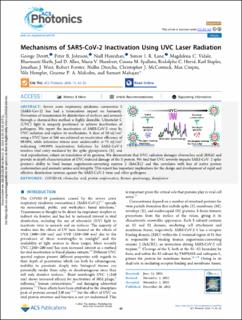| dc.contributor.author | Devitt, George | |
| dc.contributor.author | Johnson, Peter B. | |
| dc.contributor.author | Hanrahan, Niall | |
| dc.contributor.author | Lane, Simon I. R. | |
| dc.contributor.author | Vidale, Magdalena C. | |
| dc.contributor.author | Sheth, Bhavwanti | |
| dc.contributor.author | Allen, Joel D. | |
| dc.contributor.author | Humbert, Maria V. | |
| dc.contributor.author | Spalluto, Cosma M. | |
| dc.contributor.author | Hervé, Rodolphe C. | |
| dc.contributor.author | Staples, Karl | |
| dc.contributor.author | West, Jonathan J. | |
| dc.contributor.author | Forster, Robert | |
| dc.contributor.author | Divecha, Nullin | |
| dc.contributor.author | McCormick, Christopher J. | |
| dc.contributor.author | Crispin, Max | |
| dc.contributor.author | Hempler, Nils | |
| dc.contributor.author | Malcolm, Graeme P. A. | |
| dc.contributor.author | Mahajan, Sumeet | |
| dc.date.accessioned | 2024-03-11T08:38:55Z | |
| dc.date.available | 2024-03-11T08:38:55Z | |
| dc.date.created | 2024-01-19T13:01:09Z | |
| dc.date.issued | 2023 | |
| dc.identifier.citation | ACS Photonics. 2023, . | en_US |
| dc.identifier.issn | 2330-4022 | |
| dc.identifier.uri | https://hdl.handle.net/11250/3121692 | |
| dc.description.abstract | Severe acute respiratory syndrome coronavirus 2 (SARS-Cov-2) has had a tremendous impact on humanity. Prevention of transmission by disinfection of surfaces and aerosols through a chemical-free method is highly desirable. Ultraviolet C (UVC) light is uniquely positioned to achieve inactivation of pathogens. We report the inactivation of SARS-CoV-2 virus by UVC radiation and explore its mechanisms. A dose of 50 mJ/cm2 using a UVC laser at 266 nm achieved an inactivation efficiency of 99.89%, while infectious virions were undetectable at 75 mJ/cm2 indicating >99.99% inactivation. Infection by SARS-CoV-2 involves viral entry mediated by the spike glycoprotein (S), and viral reproduction, reliant on translation of its genome. We demonstrate that UVC radiation damages ribonucleic acid (RNA) and provide in-depth characterization of UVC-induced damage of the S protein. We find that UVC severely impacts SARS-CoV- 2 spike protein’s ability to bind human angiotensin-converting enzyme 2 (hACE2) and this correlates with loss of native protein conformation and aromatic amino acid integrity. This report has important implications for the design and development of rapid and effective disinfection systems against the SARS-CoV-2 virus and other pathogens. | en_US |
| dc.language.iso | eng | en_US |
| dc.rights | Navngivelse 4.0 Internasjonal | * |
| dc.rights.uri | http://creativecommons.org/licenses/by/4.0/deed.no | * |
| dc.subject | COVID-19 | en_US |
| dc.subject | ribonucleic acid | en_US |
| dc.subject | protein conformation | en_US |
| dc.subject | disinfection | en_US |
| dc.subject | Raman spectroscopy | en_US |
| dc.title | Mechanisms of SARS-CoV-2 Inactivation Using UVC Laser Radiation | en_US |
| dc.title.alternative | Mechanisms of SARS-CoV-2 Inactivation Using UVC Laser Radiation | en_US |
| dc.type | Peer reviewed | en_US |
| dc.type | Journal article | en_US |
| dc.description.version | publishedVersion | en_US |
| dc.rights.holder | © 2023 The Authors. | en_US |
| dc.subject.nsi | VDP::Medisinske Fag: 700::Helsefag: 800::Forebyggende medisin: 804 | en_US |
| dc.source.pagenumber | 42-52 | en_US |
| dc.source.volume | 11 | en_US |
| dc.source.journal | ACS Photonics | en_US |
| dc.source.issue | 1 | en_US |
| dc.identifier.doi | 10.1021/acsphotonics.3c00828 | |
| dc.identifier.cristin | 2230367 | |
| cristin.ispublished | true | |
| cristin.fulltext | original | |
| cristin.qualitycode | 1 | |

